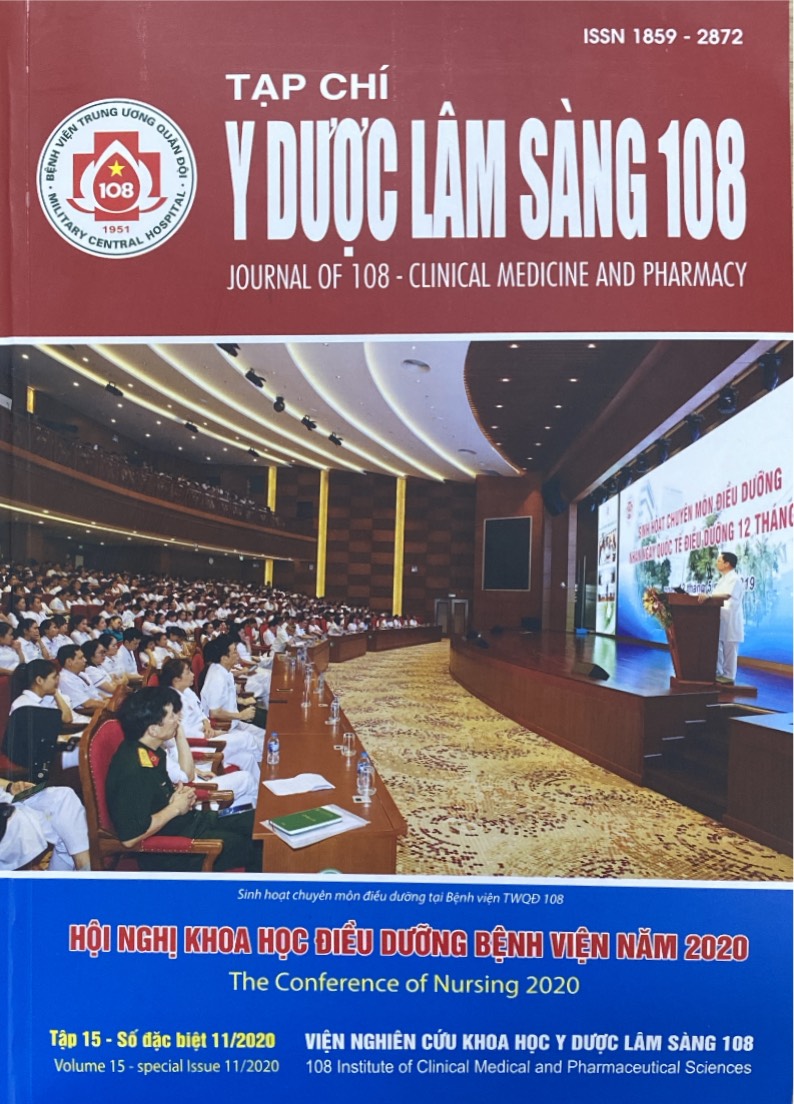Assessment of nursing care management for bleeding esophageal varices in cirrhotic patients
Main Article Content
Keywords
Abstract
Objective: To describe of clinical, paraclinical characteristics; and to assess the adherence, lifestyle changes after discharge and relationship with rebleeding esophageal varices in cirrhotic patients. Subject and method: In a prospective, design and cross-sectional study, 60 cirrhotic patients had bleeding esophageal varices in Institue of Gastroenterorlogy and Hepatology, 108 Military Central Hospital, from September 2019 to December 2019. Protocol: Carrying out nursing care management in acute venous bleeding, follow-up rebleeding rate in next 6 months. Result: The mean age was 51.8 ± 10.1 years old; 96.7% was male; 83.3% was alcoholic abusing, 100% endoscopy on 1st day. 45% endoscopy band ligation. Blood transfusion volume on 1st day was 1008 ± 263.3ml. Almost were complete care patients on only 1st day. Mean hospital duration was 7.53 ± 3.71 days. After discharge, patients were forced to change lifestyle, give up alchohol, use antivirrus, use NSBB non-selective beta blockers. After 6 months, the rate of rebleeding of patients who followed well nursing care management were lower than whose followed not well (p<0.05). Conclusion: The achieved targets are better when using nursing care management, decreasing rate of rebleeding, improving outcomes
Article Details
References
2. Garcia-Tsao G et al (2017) Portal hypertentsion bleeding in cirrhosis: Risk stratification, diagnosis, and management: 2016 practice guidedance by the American Association for the study of liver diseases. Hepatology 65: 310-335. DOI: 10.1002/hep. 28906. Epub 2016 Dec 1.
3. Goulis J et al (1999) Bacterial infection in the pathogenesis of variceal bleeding. Lancet 353: 139-142. DOI: http://doi.org/10.1016/ SO140-6736 (98) 06020-6.
4. Simon GJ et al (2017) Outcomes of restrictive versus liberal transfusion strategies in older adults from nine randomised controlled trials: A systematic review and meta-analysis. Lancet Haematol 4: 465-474.
5. Bộ Y tế (2008) Điều dưỡng nội tập 2. Sách đào tạo Cử nhân điều dưỡng, Nhà xuất bản Y học 2008, tr. 163-171.
6. Viện Nghiên cứu Y dược lâm sàng 108 (2017) Giáo trình bệnh học Nội tiêu hóa. Nhà xuất bản Y học 2017
7. Lê Ngọc Thành, Một số nhận xét về kết quả điều trị dự phòng tiên phát xuất huyết tiêu hóa do giãn vỡ tĩnh mạch thực quản tại Khoa Nội Tiêu hóa, Bệnh viện Đa khoa Thanh Hóa. http:// bsdakhoatinhthanhhoa.com.vn/tin-tuc/bai-viet-chuyen-mon.
8. Ngô Thị Thanh Quýt (2011) Khảo sát các yếu tố tiên đoán tử vong ở bệnh nhân xơ gan có xuất huyết tiêu hóa do vỡ giãn tĩnh mạch thực quản. Y học TP. Hồ Chí Minh, tập 15, phụ bản số 2-2011, tr. 147-153.
9. Trần Văn Huy (2012) Cập nhật về điều trị và dự phòng xuất huyết tiêu hóa do giãn vỡ tĩnh mạch thực quản. Y Học TP. Hồ Chí Minh, tập 16, Phụ bản của số 3.
10. Trường Đại học Y khoa Phạm Ngọc Thạch (2011) Bộ môn Dinh dưỡng-an toàn thực phẩm. Giáo trình Dinh dưỡng học, Nhà xuất bản Y học, tr. 341, tr. 523-524.
 ISSN: 1859 - 2872
ISSN: 1859 - 2872
